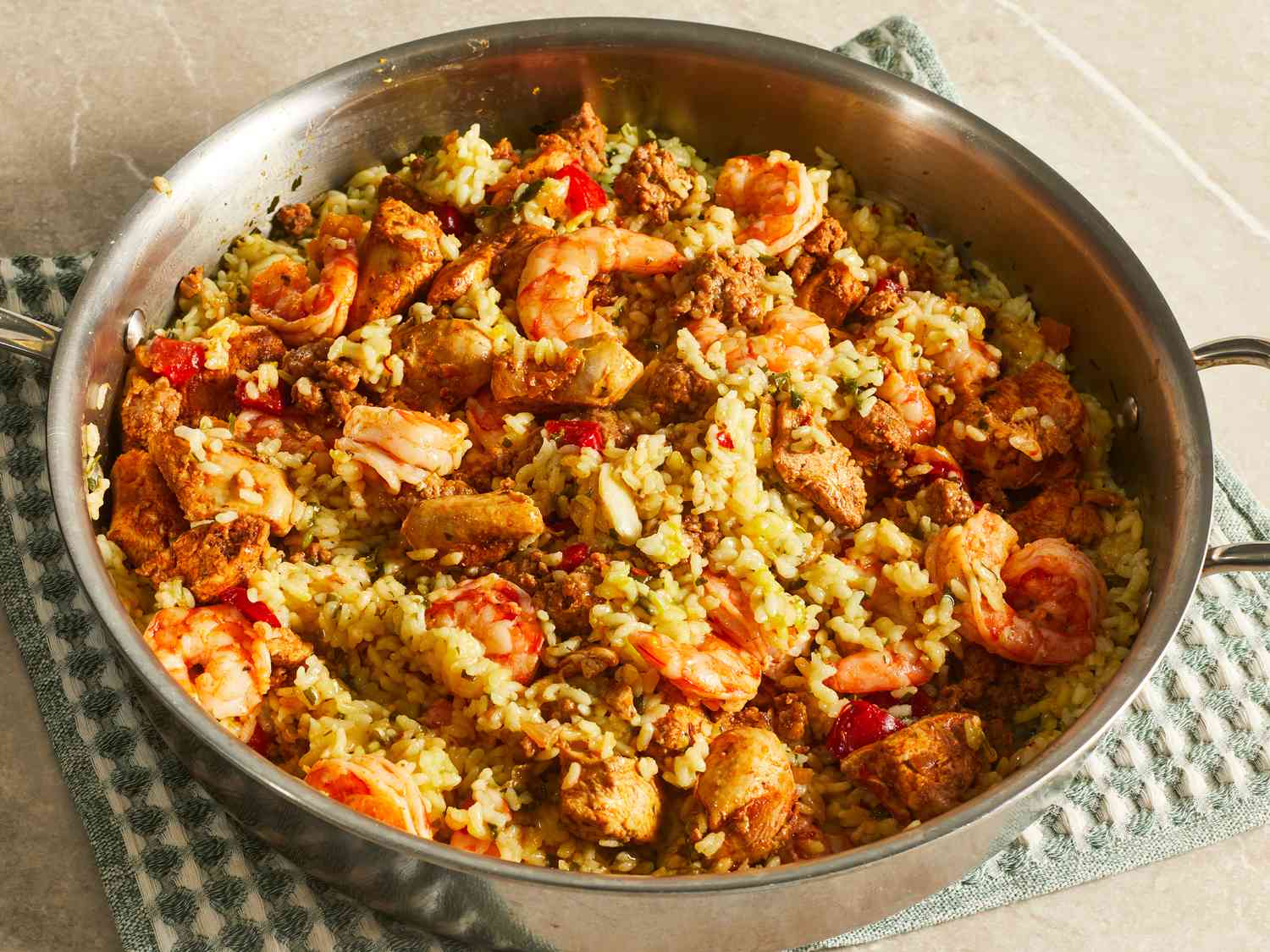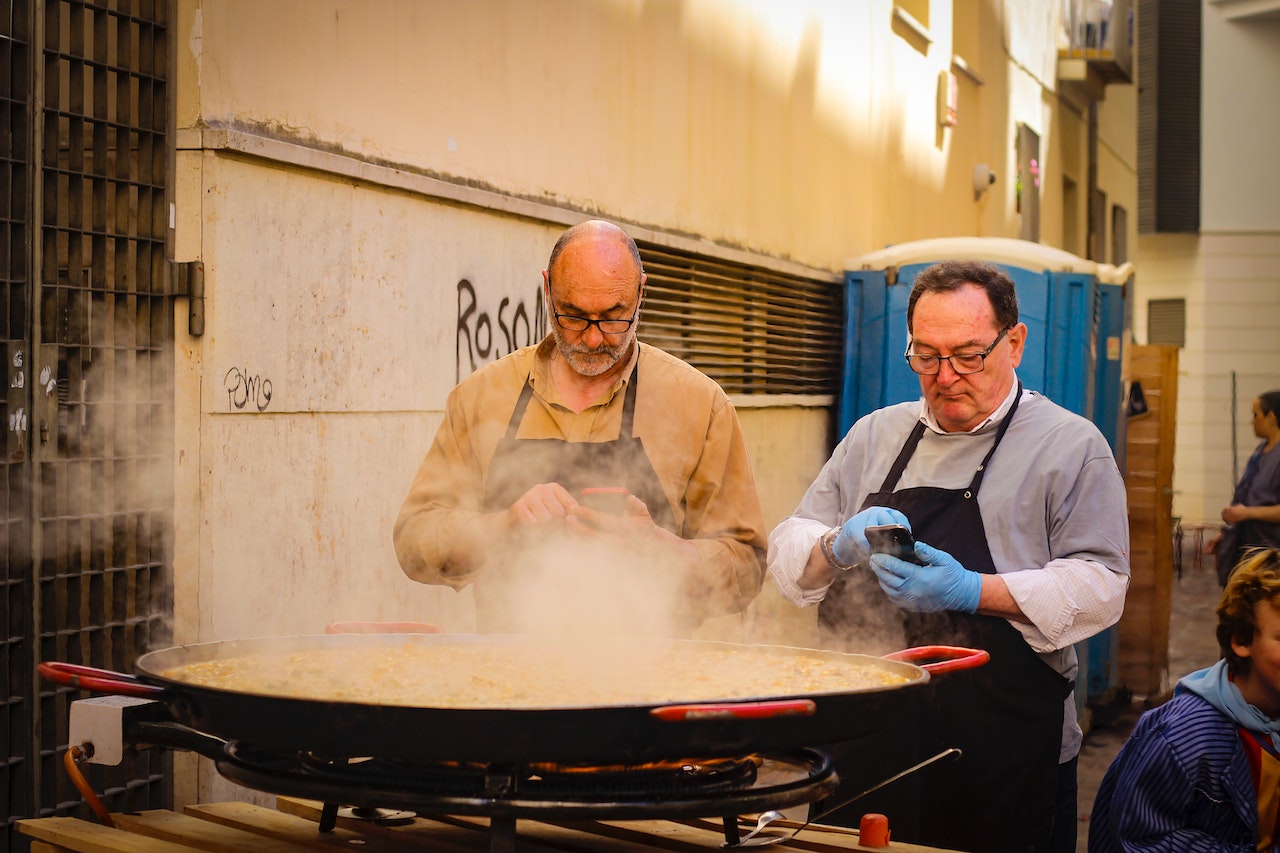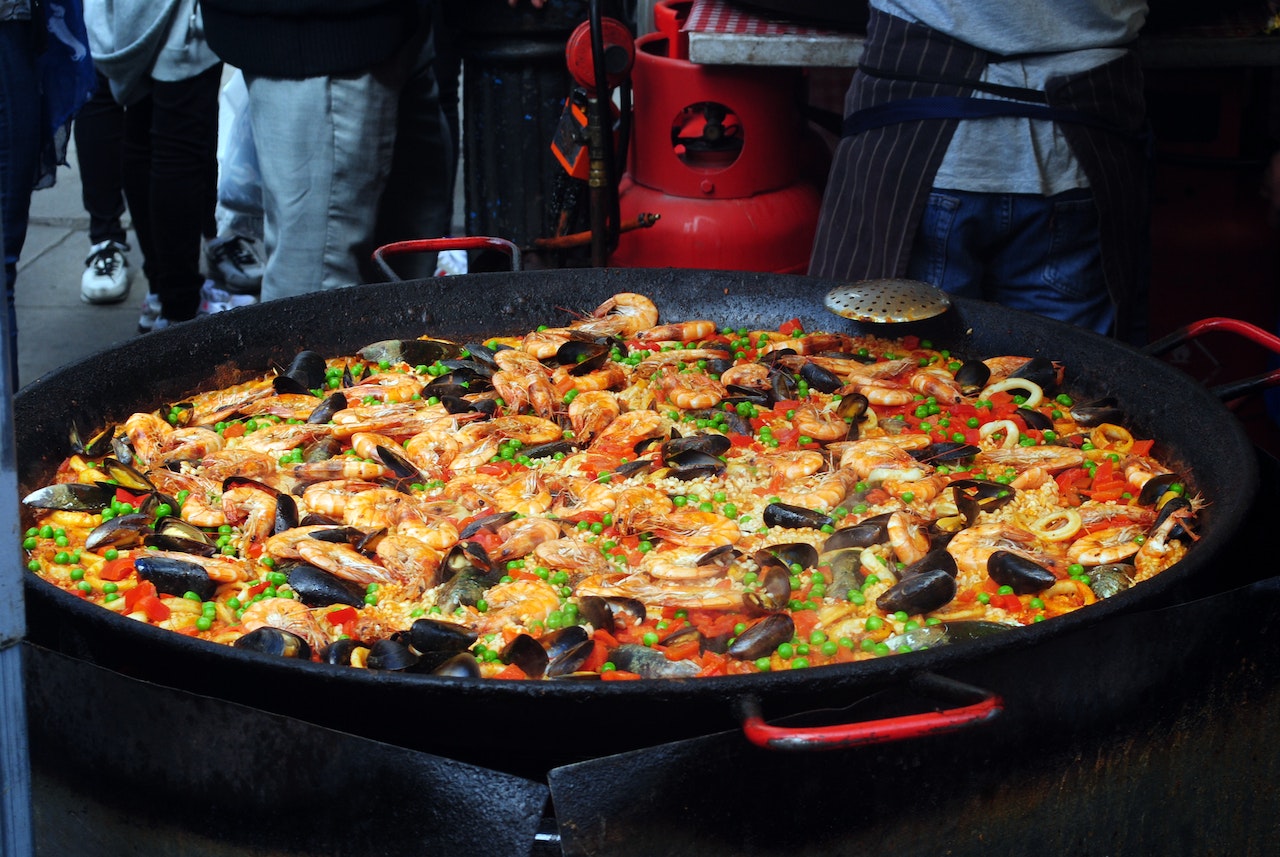
Paella, the iconic Spanish dish known for its vibrant colors and rich flavors, has captured the hearts and palates of food enthusiasts worldwide. Originating from the region of Valencia, paella has evolved over the years, and today, there are countless variations to suit various tastes and preferences.
While paella may seem deceptively simple, achieving the perfect balance of flavors and textures can be a culinary challenge. Here, you'll explore the art and tips need cooking paella.
The Origins Of Paella - A Dish Of Humble Beginnings
The history of paella can be traced back to the fields of Valencia, a region on the eastern coast of Spain. The word "paella" itself is derived from the Old Valencian word "paella," which means "pan."
Originally, paella was a humble, rustic dish prepared by farmworkers and peasants in the countryside. These early versions of paella often featured simple ingredients like rice, vegetables, and rabbit or chicken cooked in a wide, shallow pan over an open flame.
The Evolution Of Paella - Influences And Variations
Over time, paella underwent a culinary transformation, evolving into a dish that reflects the diverse influences that have shaped Spanish cuisine. Several key factors contributed to this evolution:
Arab Influence
During the Moorish occupation of Spain, which lasted for nearly eight centuries, Arab culinary techniques and ingredients were introduced to the Iberian Peninsula. This influence can be seen in using spices like saffron, a crucial component of modern paella.
Exploration And Trade
The Age of Exploration brought new ingredients to Spain from the New World, including tomatoes, peppers, and rice. These ingredients entered the paella pot, enriching its flavors and colors.
Regional Variations
Different regions of Spain developed their variations of paella, reflecting the ingredients readily available in their respective areas. For example, seafood paella became popular in coastal regions, while inland areas favored rabbit and chicken.
Socioeconomic Changes
As Spain underwent socioeconomic changes, paella transitioned from a humble, everyday dish to a symbol of celebration and communal gatherings. Preparing paella for special occasions, festivals, and family gatherings became customary.
7 Essential Paella Ingredients
While paella may include a wide variety of items, including rabbit, snails, and the abundance of seafood favored in coastal areas, the following main elements are nearly always present:
Rice
Paella rice should always be made using highly absorbent short or medium-grain rice; long-grain rice is never appropriate. Short-grain rice can help you attain the ideal, dry texture since it can absorb more water before becoming mushy. Spanish Bomba or Calasparra kinds of rice, as well as the more generally accessible Italian Arborio rice, are varieties that perform well in paella.
Sofrito
Sofrito is an aromatic base that serves as the basis for the tastes of paella, much like mirepoix does in French cuisine. Typically, Spanish sofrito uses green or red peppers, onions, garlic, olive oil, and tomatoes.
Stock Or Broth
Good paella may become superb paella with the right stock. Chicken stock is often used with meat, whereas fish stock is used in paellas with seafood. Use your stock if you have it!
Spices And Herbs
Saffron is the most crucial ingredient in a typical paella since it gives the ish its rich, golden hue. However, some paella chefs use turmeric or colors for saffron since it is cheaper than gold by weight. Pimentón, or smoked sweet Spanish paprika, and rosemary, a classic spice from when snails were a typical paella element, are two other essential spices for paella.
Seafood
Seafood paella often includes prawns, shrimp, clams, mussels, crayfish, squid, and langoustines.
Meat
Although the most common paella meats are rabbit, chicken, and snails, pig and Spanish chorizo have also gained popularity. (Paella purists, conversely, believe that the taste of chorizo overwhelms a nuanced paella.)
Vegetables
Three different kinds of beans are used in a typical paella Valenciana:
- Tavella (white bean)
- Garofalo (lima bean-like),
- Ferrara (string bean).
Outside of Valencia, however, lima beans, green beans, peas, or other varieties of white beans are often used in dishes. Paella often includes artichoke hearts and vegetarian paellas may use any sort of vegetable, including the prized calçot—a distinctive variety of Spanish spring onion—when in season.
Tips Need Cooking Paella Recipe
One of Valencia's most well-known rice dishes is called paella, Spanish for "frying pan." Paella may be prepared in a large nonstick frying pan, although a classic wide, shallow pan is preferable. Paella was created by farmers and laborers using a range of ingredients, almost mainly white meat or fish, to reduce saturated fats.
Instruction
- A big, solid skillet or a classic paella pan should be heated over medium-high heat. 14 cups more olive oil should be added to the pan, followed by 1 minute of sea salt seasoning.
- Add 15 to 20 fresh asparagus stalks, sliced into 1-inch pieces, and a 15-ounce can of artichoke hearts. Before adding them, remember to press the artichoke hearts dry with a paper towel or something similar.
- It's time to combine these items for 3 minutes softly. Artichoke hearts should be handled cautiously since they should be combined carefully and consecutively to prevent scorching.
- Half an onion should be diced. After adding chopped onions to the pan, the meal has to be mixed for 90 seconds.
- Make a well in the pan's center and cook 4–5 minced garlic cloves in oil for 30 seconds. Then, add 1 teaspoon of sweet smoked Spanish paprika and combine everything.
- Add 1 cup of frozen or jarred precooked lima beans and 1/2 cup of canned tomato sauce. If you have lima beans that aren't cooked, boil them for approximately 20 minutes.
- Add more sea salt and stir just a little more.
- 2.5 cups of vegetable broth and 1/2 teaspoon of saffron threads should be added. Quickly combine them. Letting the soup simmer for an additional minute is the ideal method for saffron infusion.
- A cup of spherical rice should be spread across the pan. Now, immediately shake the pan. Place aside.
- Once no liquid is in the pan, turn down the heat to low-medium and let it simmer for another 4-5 minutes.
- To make the famed coating of caramelized burned rice known as Socarrat, heat the pan for 60 to 90 seconds over medium-high heat.
- After turning off the heat, cover the rice in the pan with a dishtowel and aluminum foil so it may rest for five minutes.
- Remove the paella pan's lid. Lemon wedges are excellent garnish options.
Tips You Need For Cooking Paella
Making a giant pan of paella to serve at a dinner party has a certain allure, mainly because this Spanish rice dish is one of the few dishes that can be easily prepared for a party of two as it can for a party of 20 or even 200.
The number of people whom a pan of paella can feed is, more often than not, more than the number of people you could reasonably persuade to come out and eat paella at your house, as long as you have enough paella pans and ingredients to go around.
Follow A Good Recipe
Finding a paella recipe that appeals to you personally is essential if you want to prepare a fantastic paella pan. Even the most petite recipe-driven cooks should take the time to learn about the ingredients and methods used to prepare a professional paella pan.
You don't have to follow the instructions for the letter, of course. If you have never designed paella before and many hungry individuals at the dinner party are waiting for their plates, it is essential to read the instructions.
Make sure to initially take into account the source when selecting a paella recipe. And even if you have total faith in the concerned chef, feel free to compare their recipe to another to ensure all the necessary ingredients are included.
The Pan
An authentic paella pan has splayed edges that are broad, spherical, and shallow. There is no cover on it. It features two looped handles and could droop in the center a little so the oil can collect there for the first sautéing. It is made possible by the paella or paellera pan's form that the rice cooks in a thin layer.
Cooked rice shouldn't be thicker than "un ditet," or one finger's breadth (or around 1/2 inch). The goal is to ensure that as much rice as possible touches the pan's bottom since the taste is concentrated there. Paella pans thus develop in diameter rather than height.
The Heat Source
Look for a heat source large enough to fit the whole paella pan. You may need to straddle the pan over two burners or place it on your most giant burner, depending on how your burners are set up. You must move and rotate the pan to disperse the heat evenly. Alternatively, you may cook the paella outside on a large gas or charcoal grill or over a fire, as in Spanish paella contests. The simplest option is to use one of your paella burners to provide equal heat over the whole pan.
Use The Right Kind Of Rice
Not all rice is made equal, as anybody with experience cooking with several rice varieties knows. Additionally, even if you cooked 10 different types of rice in the same method on the same day, you would still get varied outcomes in each pan.
Bomba paella rice is the greatest. You guessed it—Bomba is a short-grain white rice with Spanish roots. The classic rice used in paella is called bomba because of its remarkable textural integrity and flavor absorption.
Even if Bomba rice is the greatest, it's okay if you need to switch to a more affordable option. You only need short-grain white rice that can withstand a moderate simmer; risotto rice, also known as Arborio, is a popular alternative that should work well.
Balance All Seasonings
Saffron, paprika, and sofrito, a complex and savory spice mixture produced from a variety of aromatics such as dried onion, tomato, garlic, pepper, and so on, are the three main spices that make up the taste profile that makes paella renowned. You can create a paella so enticing by using these three spices (plus a bay leaf if you're feeling fancy) that even the scent will have neighbors clamoring over your garden gate for their own dish.
When used with a complex spice combination like sofrito, saffron is a famously tricky spice to get precisely correct since it can easily overpower or underwhelm a meal. Make careful to taste your seasoning mix before adding it to the dish so you may make modifications in advance rather than in the heat of the moment. This will help you prevent paella spice chaos.
The Cooking Liquid
The rice is cooked while being infused with flavor by a savory liquid. Make a handmade stock of the components in the paella if you still need to get some on hand. For a fast, tasty stock, boil the shells in salted water for paella with shrimp.
Pick a low-salt store if you decide to use canned stock. Water may also be used, as many Spanish home chefs do. Saffron is incorporated into the liquid almost always in paella recipes, giving the rice color and a little background taste.
FAQs
What Is The Secret To A Good Paella?
Exemplary paellas To get a crunchy crust known as socarrat, the bottom layer of rice must be cooked entirely.
How Do You Know When Paella Is Cooked?
Use a spoon to taste a small amount of rice near the pan's edge to determine if the paella is cooked; this rice will be the last to be done cooking since it is the furthest from the source of heat.
What Are The Key Elements In Paella?
Traditional paella uses short-grain rice, saffron, meats, shellfish, vegetables, and olive oil.
What Cooking Method Is Used For Paella?
Over a wood fire, you may quickly and cheaply prepare paella. In Spain, it's also the technique that paella purists prefer.
Is Paella Hard To Cook?
The combination of saffron and tomato-flavored rice with meat or shellfish seems extraordinary, but it's easy to create at home.
What Is The Best Oil For Paella?
Start by selecting a Spanish Extra Virgin Olive Oil for this meal. Because of it, the most incredible taste and smells are assured.
Conclusion
Cooking paella is an art form that demands attention to detail and a deep appreciation for the ingredients. With the right pan, high-quality ingredients, following the tips need cooking paella, and a commitment to building layers of flavor, you can create a paella that transports your taste buds to the sunny shores of Spain.
Remember to be patient, as mastering the art of paella may take some practice, but the delicious rewards are well worth the effort. So, roll up your sleeves, gather your ingredients, and embark on a culinary journey that celebrates the vibrant flavors of Spain's most iconic dish. ¡Buen provecho!


